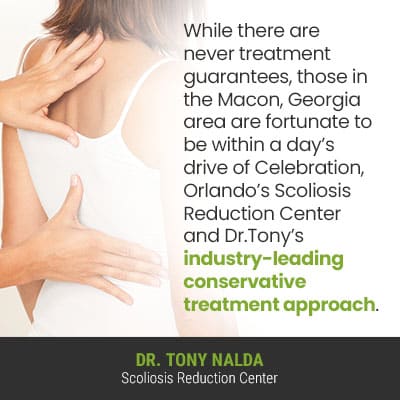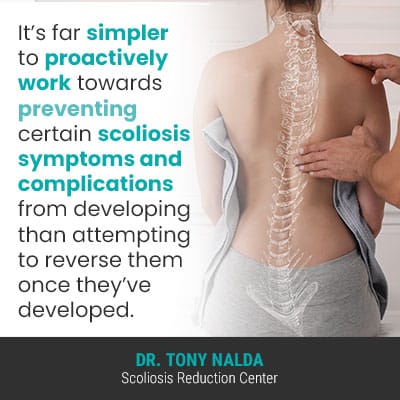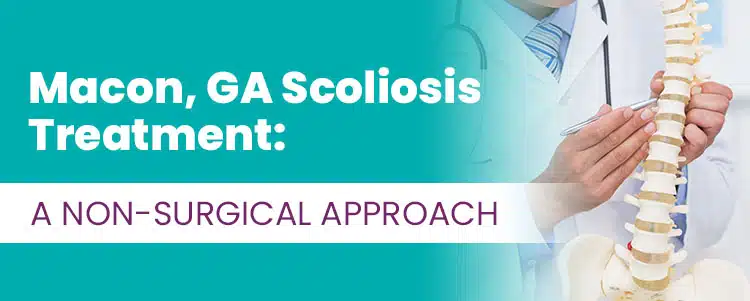There is more than one way to treat scoliosis, which is why it’s so important for patients to ensure they are informed on all treatment options available to them. For many years, the traditional approach was the dominant choice, commonly funneling patients towards spinal fusion surgery, but a modern conservative treatment approach has been steadily growing in results and popularity: one that offers patients a non-surgical treatment alternative.
Those in need of Macon, GA non-surgical scoliosis treatment have only 362 miles, and a 5.5-hour drive, between them and leading scoliosis chiropractor, Dr. Tony Nalda, of the Scoliosis Reduction Center®.
Before getting to the specific differences between a traditional and conservative scoliosis treatment approach, let’s first define the condition and the parameters that have to be met in order to reach a diagnosis of scoliosis.
Being Diagnosed with Scoliosis
Being diagnosed with scoliosis can be confusing for patients and their families; scoliosis is a complex spinal condition that requires proactive treatment that works by counteracting the condition’s progressive nature.
Scoliosis involves the development of an unnatural spinal curve, with rotation, which makes it a 3-dimensional condition, and it can range widely in severity from mild to moderate and severe to very severe.
As a progressive condition, scoliosis diagnosed as mild isn’t indicative of where it will stay; if left untreated, or not treated proactively, the size of the unnatural spinal curve will increase, introducing more and more uneven forces to the body, with increasing effects.
Scoliosis can affect all ages, but is most prevalent in adolescents between the ages of 10 and 18 as adolescent idiopathic scoliosis (AIS).
Idiopathic scoliosis means it’s not clearly associated with a single-known cause, and is instead thought to be multifactorial: caused by a combination of variables that can differ from person to person.
Idiopathic scoliosis accounts for approximately 80 percent of known diagnosed scoliosis cases, while the remaining 20 percent are associated with known causes: neuromuscular scoliosis, degenerative scoliosis, and congenital scoliosis.

While there are never treatment guarantees, those in the Macon, Georgia area are fortunate to be within a day’s drive of Celebration, Orlando’s Scoliosis Reduction Center® and Dr.Tony’s industry-leading conservative treatment approach.
Why Early Detection and Intervention Can be so Beneficial
As a progressive condition, virtually every case of scoliosis is guaranteed to worsen at some point, but a condition’s progressive rate can be managed effectively, if treated effectively.
When caught early in a condition’s progressive line of mild to moderate and severe to very severe, scoliosis can be highly treatable.
Scoliosis progressing means it is becoming more complex to treat; this is because as the scoliotic curve increases in size, the spine is becoming more rigid, making it less responsive to treatment, and less able to perform certain therapeutic exercises and stretches that are a key facet of treatment.
In addition, the longer scoliosis is left to progress unimpeded, the more likely related muscle imbalances are.
It’s not just the spine that’s in charge of maintaining its natural curves and alignment, but also its surrounding muscles, and an unnaturally-curved spine pulls its surrounding muscles in different directions, and over time, this can cause muscles on one side of the spine to become stretched and loose from overuse, and muscles on the opposite side to become weak from underuse.

It’s far simpler to proactively work towards preventing certain scoliosis symptoms and complications from developing than attempting to reverse them once they’ve developed.
In fact, in cases where a significant amount of progression has already occurred by the time a patient comes in for a diagnosis and treatment, as is quite common in adult scoliosis, a certain amount of preparatory work has to be done to establish a baseline level of spinal flexibility, before starting the regular course of treatment.
What is Traditional Scoliosis Treatment?
Traditional scoliosis treatment was the dominant response for many years, but despite our evolving understanding of the condition over the years, and treatment efficacy, little has changed in how traditional treatment responds to a diagnosis of mild scoliosis.
In most cases of mild scoliosis, those on the path of traditional scoliosis treatment are told to watch and wait for continued progression, but this is wasting valuable treatment time because as a progressive condition, we already know it has it in its nature to get worse over time.
Traditional treatment doesn’t have a strategy for treating scoliosis while mild so recommends watching and waiting, until a condition progresses into the severe classification with a Cobb angle measurement of 40+ degrees, and at this point, the patient becomes a surgical candidate.
Scoliosis surgery, aka spinal fusion surgery, is associated with a number of potential side effects, and both short and long term, and complications.
The traditional reactive response to a diagnosis of mild scoliosis is opposite to a proactive response that characterizes a non-surgical conservative scoliosis treatment approach.
What is Conservative Scoliosis Treatment?
The Scoliosis Reduction Center® of the Celebration, Orlando area is a mere 5.5-hour drive from Macon, Ga, so those in search of proactive non-surgical scoliosis treatment can access the type of treatment many cross the globe for.
Conservative treatment is also known as functional and/or chiropractic-centered, and it involves customizing each and every treatment plan by integrating multiple treatment disciplines and adjusting them accordingly.
That is a major benefit for patients of the Center: having access to multiple condition-specific treatment modalities under one roof.
I combine chiropractic care, physical therapy, corrective bracing, and rehabilitation for structural results that are complemented by physical therapy that also impacts the spine’s surrounding muscles.
A series of chiropractic techniques and adjustments are applied to work towards readjusting the position of the curve’s most-tilted vertebrae back into a healthier alignment with the rest of the spine.
Once I achieve structural results in the form of a curvature reduction, I apply physical therapy to increase the strength of the spine’s surrounding muscles so they can provide optimal spinal support/stabilization.
Corrective bracing can be particularly effective on growing spines, and when combined with other forms of proactive treatment, corrective bracing can help by pushing the spine into a corrective position.
The final phase of treatment involves educating patients on how to lead a scoliosis-friendly lifestyle, the requirements of continued chiropractic care, and the prescription of customized exercises to help patients establish a home-rehabilitation program for long-term sustainable treatment results.
Conclusion
While I can never give treatment guarantees, the best time to start a proactive scoliosis treatment approach is always now; that way, treatment can be started when the spine is going to be the most responsive, and before the condition’s effects become more complex to reverse.
Scoliosis ranges in severity from mild to moderate and severe to very severe, and different treatment approaches offer patients different potential outcomes.
A traditional scoliosis treatment approach doesn’t have a strategy for proactively addressing scoliosis while mild, so waits passively until conditions become severe enough to warrant a surgical recommendation.
While spinal fusion continues to have a place in severe and very severe scoliosis treatment, the reality is that many cases of scoliosis can be addressed with non-surgical conservative treatment with proven results.
In fact, residents of Macon, Georgia are only 362 miles away from leading non-operative scoliosis treatment at the Scoliosis Reduction Center® in Celebration, Florida.




